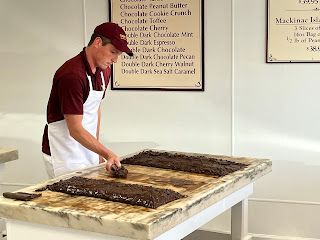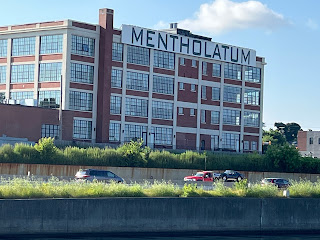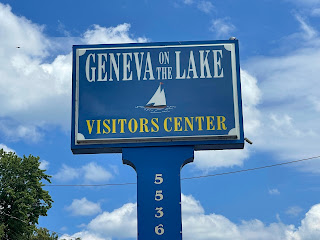On August 4, after two nights in Detroit, we pulled out of our slip back onto the Detroit River heading north. The current in this river is fairly strong at 2-2.5 mph and we had to weave around a couple of very large freighters anchored in the middle of the river. For a little geographical reference, the Detroit River connects Lake Erie to Lake St. Clair which in turn is connected to Lake Huron by the St. Clair River. The western shores of the waterways are Michigan and the eastern shores are Ontario, Canada. Lake St. Clair is relatively small and very shallow with an average depth of only 11 feet. Our initial plan called for us to tie up at a state park on the shore of Lake St. Clair but at the height of the summer boating season it was getting difficult to find dock space for a boat of our size, especially on the weekends. So we had to alter our plans and cruised across the lake to Algonac, Mi. Algonac sits at the southern end of the St. Clair River where its junction with the lake forms the largest fresh water delta in the world! Rich in boating history, Algonac was the home of Chris Craft boats and Gar Woods boats. Although no longer a family owned business, Chris Craft is still a well-known and respected brand and was the world’s largest producer of mahogany boats. Gar Wood boats closed in the 1940s but Gar Wood, who made his initial fortune by inventing a hydraulic lift for coal trucks, produced some of the most respected and fastest race boats of his day. Our stay in Algonac was unremarkable and included dinner at a restaurant whose old Chris Craft memorabilia collection was far better than its prime rib special.
Moving north from Algonac our next stop would be at Lexington, MI on Lake Huron. To get there we traveled upstream on the St. Clair River. The elevation of Lake Huron at the north end of the river is 577’ whereas the elevation of Lake Erie to the south is 569’. This means a lot of water has to flow downstream through this river producing a significant current. The northern end of the river is bordered by Port Huron on the Michigan side and Sarnia on the Canadian side. Traversing this area, I was more than a little surprised to see more greenery on the US side of the river and more industrial blight on the Canadian side. At the narrowest part of the river the two sides are connected by the Blue Water Bridge. The current as we were passing under this bridge was 5-6 mph against us. Many loop boats are only capable of speeds around 7-8 mph which means they are barely moving as they traverse this section of river. Fortunately, or actually –by design, Off Leash has plenty of power. I was able to punch up her diesels and maintain a 12 mph headway as we made our way onto Lake Huron. BTW… Lake Huron took its name from the Native American tribe, the Hurons. Its shores were also home to the Chippewa and Odawa all of whom became avid fur traders with the French.
Port Huron - Michigan
Sarnia, OntarioBlue Water Bridge
Lexington Harbor was our first stay in a Michigan State Park Marina which can be found along much of the coast of Michigan, both on the Lake Huron and Lake Michigan sides. Most of these are also referred to as harbors of refuge. With the Great Lakes reputation for nasty winds and rapidly building seas, these harbors must offer boaters refuge when needed. They usually keep a couple of slips open for emergency refuge or can tie up boats on their fuel dock overnight. The docks are kept in excellent condition and are usually accessible even through the winter. While there we enjoyed chatting with local boaters and that night there was a concert in the adjacent park with a great band featuring a phenomenal female vocalist.
We woke up the next day hoping to get an early start on our next 42 mile leg to Harbor Beach. When we woke up that morning, we were shrouded in our first exposure to fog. It was thick. We could just barely make out the entrance to the harbor. I had faith in our electronics and wanted to get underway but Karen was convinced it was too dangerous and wanted to wait. Well, to support her point of view, a sailboat that ventured out that morning made a wrong turn and got stuck on the bottom in shallow water. So we waited for the fog to lift and had a nice cruise. All was good until we arrived at the marina. Just as we rounded the dock towards our slip the winds suddenly made an appearance and blew us all around as we tried to back into the slip. Fortunately the slip next to ours was also open and we were able to slide in and tie up…. No harm, no foul. The highlight of our day at Harbor Beach was a visit from our friends, John and Lucy, the couple we met and toured with back on the Hudson River. They had finished their loop and were driving near the area after a visit to Canada. It was great to catch up with them over lunch and they brought us some peaches from a farmers market that were the best we have had in a long time….Thanks John and Lucy!
Michiganders like to refer to
Michigan as looking like a mitten. If you hold up your left hand, keep your
fingers together but extend out your thumb, when you look at the back of your
hand you are looking at Michigan. Harbor Beach is on the outside of your thumb.
Our next stop at Harrisville would be a little past your knuckle of your index
finger. To get there, we would have to travel up the rest of the thumb and then
cross the space between the thumb and the fingers, a body of water called
Saginaw Bay. Crossing past this bay meant roughly 40 miles of open water in an
area known to whip up easily. We also had conflicting reports that day for
thunderstorms. So, we were a bit nervous as we set off that morning. We decided
to throttle up for an hour to get ahead of the storms and the plan paid off. We
made it with relatively calm seas and no trauma. It’s nice to have the power to
speed up to avoid potentially bad weather. Unfortunately, speed does come with
added cost as we burn over twice as much fuel per mile going 18 mph than we do
at 9 mph. We harvested our fair share of dinosaurs that day but we got in
safely.
There was not much to do or see
in Harrisville but this stop did become memorable. A marina staff member drove
us as well as our friends Jim and Cheryl from Classea and Bob and Mary-Kay from
Pilar to a brewery for lunch. The lunch itself was unremarkable but….. the
coconut cream pie was absolutely incredible. We all agreed it was the best pie
any of us had ever had!
Our next two travel days took us to Alpena and then Presque Isle State Harbor. As we made our way up the coast of Michigan we noticed then water got much clearer. By the time we got to Presque Isle it was almost perfectly clear. We took the dinghy out from the marina for a ride to a beach where we hung out for a few hours and swam in the rather frigid water. We also took a rather long walk to see both the old and the new light houses.
The 1800s saw an ever increasing amount of maritime traffic on Lake Huron. With the opening of the Erie Canal in 1825 boats could navigate from New York City to Cleveland, Detroit, Chicago, St. Louis and New Orleans. Lighthouses became very instrumental at guiding ships through violent storms, thick fog, shifting sand bars and rocky reefs. Presque Isle (French for “almost an island) was the largest natural harbor between Detroit and Mackinac and was therefore used by many ships to take on wood for fuel. The original 30’ lighthouse on Presque Isle was built in 1840. In 1870 a new 133’ lighthouse was built. An entry in its logbook dated July 1, 1878 noted that from July 1, 1877 to June 30, 1878, 8,942 vessels or steamers passed by this lighthouse! Each lighthouse has an accompanying home for the keeper and his/her family. The automation of the lighthouses in 1970 made the position of keeper obsolete but the homes at the Presque Isle lighthouses have been preserved as museums. Patrick Garrity lit the lamp of the new lighthouse for the first time in 1871 and remained its keeper until 1885. His wife, daughter and three sons all served as keepers of lighthouses in this area. We climbed to the top of both lighthouses and enjoyed the views.
Our next voyage would take us to the northernmost point of our loop at Mackinaw City. This area is a huge vacation destination and has quite a lot to offer. Fudge seems to be one of the first things on anyone’s mind as they venture into the city. Fudge shops are everywhere and they all seem to make some claim to be the original fudge maker for Mackinaw. The fudge is made in the storefronts on large marble or stone tables. I wish I could say we had the self-control to resist the chocolaty temptation but, alas, we could not. Northern Michigan is also one of the few places in the US where you can find pasties. No, not the kind strippers wear. Pasties are meat and potato filled pastries that were made as an easily hand held lunch for miners, fishermen and other workers. Many folks in the area find them to be a comfort food. Karen and I each tried one for lunch one day….they were ok but for true comfort food I’d rather have a good mac and cheese or my mom’s parmesan baked chicken!
Mackinaw City is also the home to the US Coast Guard Icebreaker Mackinaw. Also known as “Queen of the Great Lakes”, at 290’ this beauty is the largest of the Great Lakes icebreakers. Her construction was authorized by congress December 7, 1941, ten days after the attack on Pearl Harbor as part of the war effort to keep the shipping lanes open for movement of steel and other supplies. Commissioned December 30, 1944 she plied the waters of the great lakes until her retirement in 2006. She is now open as a museum and our tour of her was a highlight of our time there. With 10,000 HP diesel electric engines and an addition bow propeller to help move broken ice away she is a formidable beast. She has now been replaced by smaller more economical ice breakers but she will always hold a special place in the hearts of Great Lakes mariners.
No visit to Mackinac Island would be complete without a visit to the Grand Hotel. First opened in 1887, the hotel was built in 93 days by a consortium of railroad and steamship companies. Yes… you heard me right… 93 days! Although it is a spectacular hotel, the demands for it to be completed on time did lead to some irregularities such as hallways that slant up and down. There are 388 guest rooms and no two are the same. At 660’ long, the front patio overlooking the grounds and the Straits of Mackinac is known as the longest patio in the world and one of the iconic images of the island. Life just doesn’t get much better than sitting in one of the many white rocking chairs on the patio and gazing out over the hundreds of red geraniums in planter boxes to the views of the grounds and the Straits of Mackinac. The dining room of the hotel is also an incredible sight with seating for over 750 guests and views overlooking the patio terrace. Dinner in the main dining room still requires a coat and tie for men. Fortunately, we were there for lunch when the dress coat is not so stringent. Lunch is buffet style and the variety and quality of the offered foods were like no other buffet I had ever seen. The hotel is on the US National Register of Historic Places, a US National Historic Landmark and a Michigan State Historic Site. The hotel also has also served as the setting for the 1947 musical comedy The Time for Keeps with Jimmy Durante and Esther Williams. And, of course, our generation, especially the ladies, remember the hotel as the backdrop for Somewhere in Time with Christopher Reeve and Jane Seymour. Knowing this, I watched and Karen re-watched the movie the night before we went. All I can say is …. Guys… don’t waste your time… aside from a little eye candy, one of the worst movies I have ever seen!
Being the northernmost point of our loop, I consider Mackinaw City to be our halfway point. We started our loop on April 2, 2022 and arrived in Mackinaw four months later on Aug 12. We have had 74 separate voyaging days and have travelled 2,922 miles and run our engines for over 400 hours. More importantly, Karen and I are still talking to each other despite living on a boat together for over five months. So far so good. It should be all downhill from here.




























































































